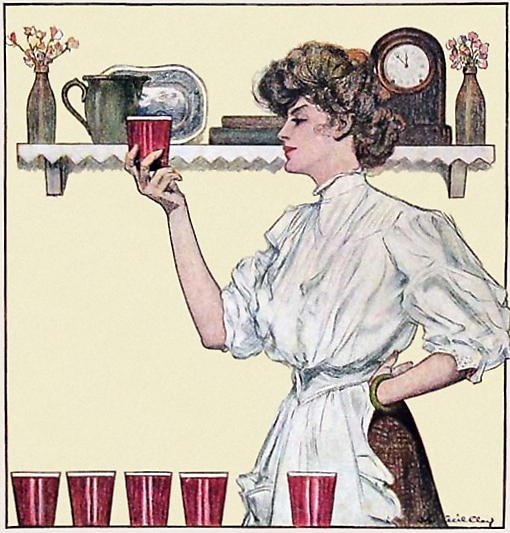
Introduction

Cookbooks are a ubiquitous thing in our time, and have existed in some form or another throughout history. People have been writing down their recipes to share with friends, family, and strangers for ages. This is great for finding the perfect souffle recipe, but cookbooks can also have other uses beyond helping people make food.
The historical significance of cookbooks can be analyzed in a number of ways. One can find information about what ingredients were available, how other cultures and immigration influenced the diet of a given society, and even what was considered safe or unsafe to eat (Boles, 2006). They can also be used to fill in the gaps for a field of history that has only relatively recently begun to be explored: women's experiences.
In the past, women and their stories were thought to be simply not worth documenting during a given time period, and not worth researching for historians looking at that time period. As a result, it is often difficult to find information about women's experiences in many historical accounts. This leads to the need to turn to what might be considered more unconventional sources, such as cookbooks.
The Project
Within this project, I will seek to show how cookbooks can be used a source of women's experiences during the 19th and early 20th century. Their lives and the expectations placed on them are certainly depicted within these books. I have attempted to use analytical tools as well as textual analysis of the contents of these books to prove this point. I hope that my fellow students and any other researchers might be inspired by this project to look in unusual places to find pieces of history.
The dataset used for this is the Feeding America: The Historic American Cookbook dataset from Michigan State University. It contains the full text of 76 American cookbooks spanning from 1798 to 1922. The majority of my conclusions regarding women's history and the usefulness of cookbooks as history will stem from this dataset and its contents. Women during this time would frequently be relegated to the domestic sphere, with the rise of the suffrage movement emerging toward the end of the 19th century, and information can be found in these cookbooks to reflect that.
Keyword Analysis
Despite the majority of the books focusing primarily on recipes, many of them contain information about women's domestic lives beyond simply explaining how to make different foods. Over the course of the 19th century, this was a trend that went from a near cult-like belief in the importance of women as housewives to the idea that social problems could be solved if the household was run more like a business (Dantec-Lowry, 2008). I chose words that related to the home, such as “family,” “domestic,” and “household," and words that related to men and women, such as "woman," "mrs", and "husband."
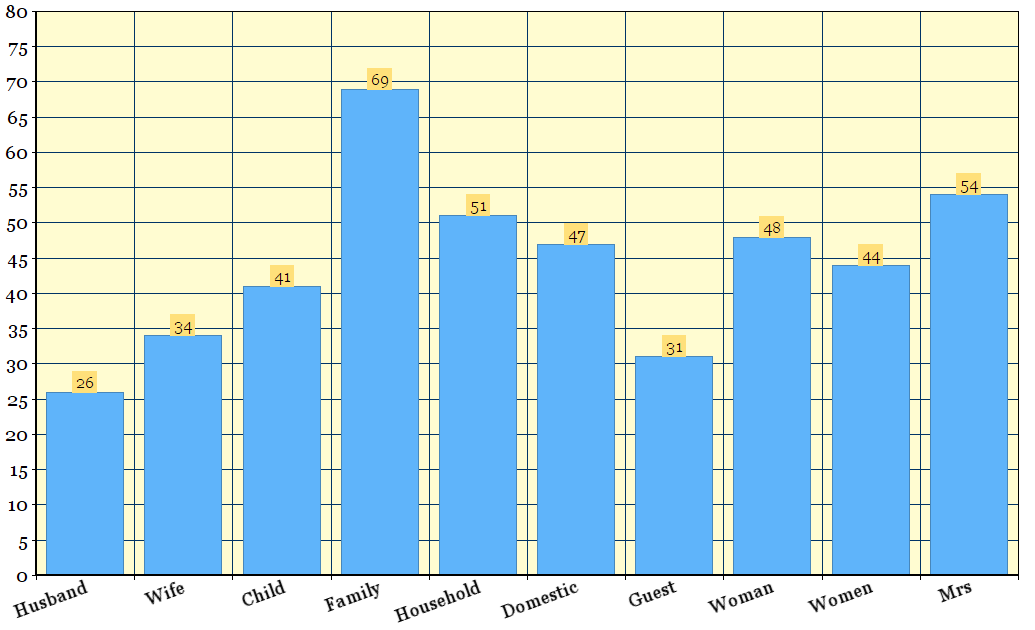 Frequency of documents with keywords in the Feeding America dataset. Created using Online Chart Tool.
Frequency of documents with keywords in the Feeding America dataset. Created using Online Chart Tool.
The fact that the word “family,” for example, can be found in 69 of the 76 cookbooks is certainly an indicator that cookbooks from this time period frequently mentioned life at home. As well, the words “domestic” and “household” are mentioned in a large number of the books, indicating the same. This is not an exhaustive list of terms that might be indicators for women's history, but these results show that there is some truth to the idea that that information can be found in cookbooks.
The word “Mrs” is easily found within these cookbooks. It is used as a frequent prefix to women's full names, either when the author of the book or recipe's name is written or when other women are referenced. The common use of this prefix already tells us something of women's lives in America during the 19th century: marital status and corresponding suffixes were considered a defining factor, important enough to be placed before a woman's name when it appeared in print. “Mrs” can be found so frequently that it is one of the most common words in a few of the cookbooks, including Buckeye Cookery (no author, 1877) and The Blue Grass Cook Book by Minnie C. Fox (1904).
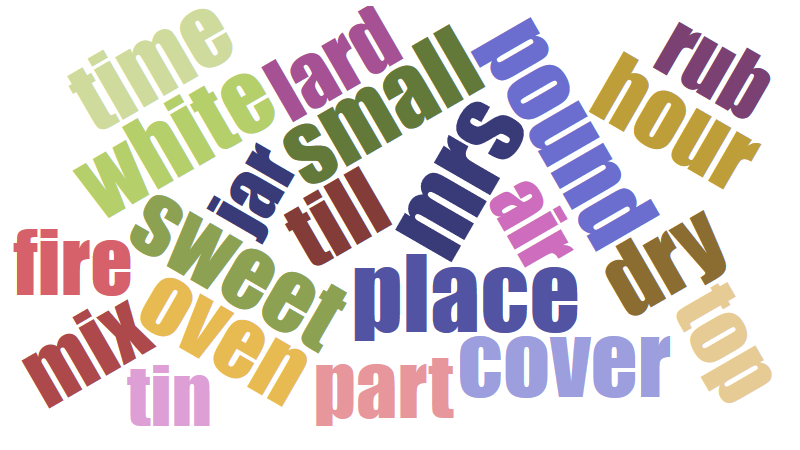 Word cloud for Buckeye Cookery (1877), after some initial stopword scrubbing. Created using Lexos.
Word cloud for Buckeye Cookery (1877), after some initial stopword scrubbing. Created using Lexos.
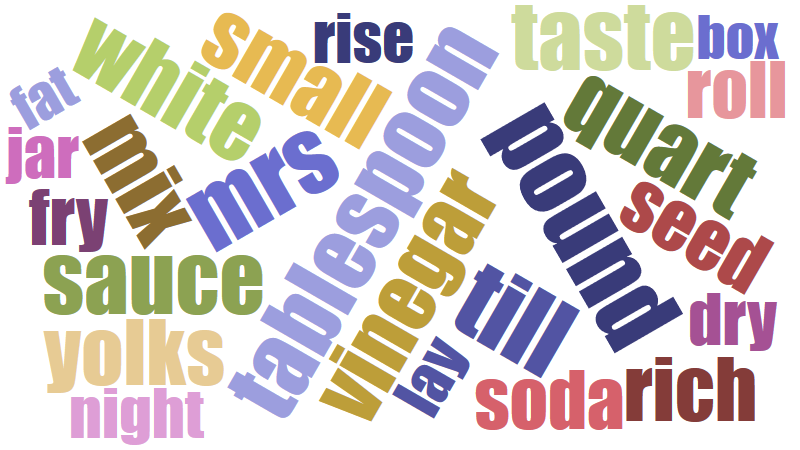 Word cloud for The Blue Grass Cook Book (1904), after some initial stopword scrubbing. Created using Lexos.
Word cloud for The Blue Grass Cook Book (1904), after some initial stopword scrubbing. Created using Lexos.
“Guest” was chosen to represent the social aspect of women's lives, as they would often serve as entertainers within their own home. “Husband” and “wife” are slightly more uncommon, especially the former, which may tell us that either these terms were not used to discuss relationships, or that marital relations were less of a focus in the advice of the books.
Simply using these initial keywords is a solid start when determining how much information can be extracted from these books, but a more thorough search will have to be carried out to determine the context behind these words' appearances. It is therefore a useful endeavour to also extract and display the information contained within the individual cookbooks from this dataset.
Experiences From Within the Text
The lives of women during much of this time were often restricted to the home and to matters pertaining to the home. They were expected to be the mistresses of their households, taking care of the house and the family, but they often had little to no influence in anything outside of the home. Although upper-class women might have servants, many middle-class women were expected to cook, and so might turn to cookbooks for instruction. These cookbooks were filled with advice about cooking (as they might be today), but also contained advice about proper behaviour for women. These cookbooks and manuals were often seen as extremely useful guides in being an effective housekeeper (Clements, 2003).
One of the most notable cookbooks from the dataset is The American Woman's Home by Catharine Esther Beecher and Harriet Beecher Stowe (of Uncle Tom's Cabin fame), published in 1869. The book is rife with advice for how to be a proper woman in the household, becoming a notably clear reflection of the home-centred life of 19th century women. The book goes into detail regarding how to keep a clean and Christian home, and how to use food, drink, and even proper ventilation to keep oneself and one's family healthy. Much about these social expectations can be found within it, and this is clearly reflected in a visualization of the words used most frequently within the book.
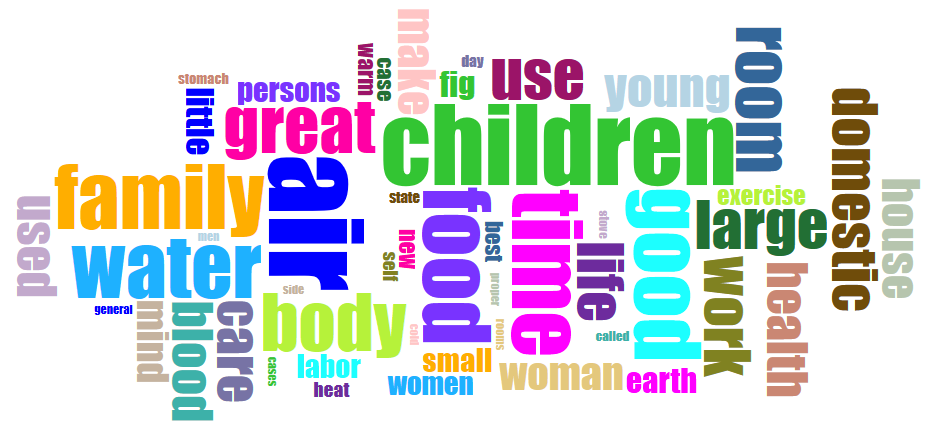 Word cloud for The American Woman's Home (1869). Created using Voyant.
Word cloud for The American Woman's Home (1869). Created using Voyant.
Several of the documents reflect on religion, especially Christianity. They stress the importance of the Christian ideals of the time, with special attention given to what was considered the moral nature of different types of food and different ways of preparing food. Statements such as “Many a Christian is trying to do by prayer that which cannot be done except through corrected diet” (Kellogg, 1893) can be found in a few of the cookbooks, indicating the correlation between religion and the household.
This is not to say that cookbooks only discuss continuity in domesticity for women – a search through all of the cookbooks for the term “suffrage” turns up three cookbooks that provide in-depth stories and explanations for why a woman's right to vote is a valuable thing. All are from the late 19th and early 20th century (with publication years in 1890, 1909, and 1915), reflecting the same time period as the suffrage movement. Statements such as “Milk, bread and water are no longer controlled by the woman in her home, living in cities and towns; and just because women want to look out for their families they should have a voice in the larger problems of municipal housekeeping” (Thomas, 1915) depict the justifications for suffrage. This information indicates that feminism took a different form back then – instead of wishing to be treated as equals, women accepted that their role was in the domestic sphere, but understood that public involvement was necessary to better carry out this role.
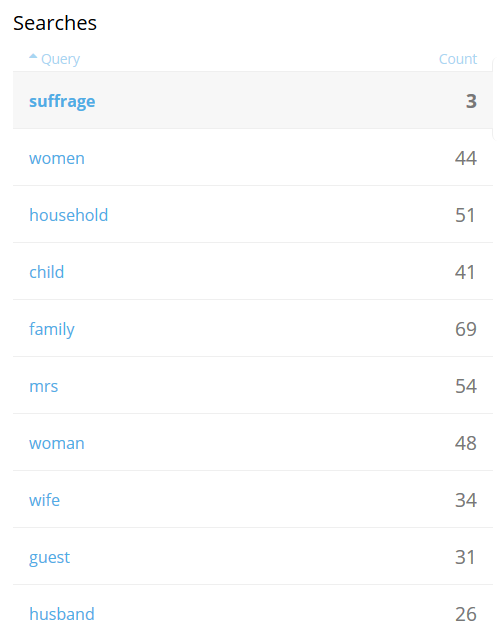
Screenshot of search terms, including "suffrage." Created using Overview.
When searching for other major events and issues surrounding this time period, a search for terms such as “slavery” and “emancipation” actually turns up more information about women's suffrage, within terms such as “women's emancipation” (Harland, 1875). While there are certainly cultural, racial, and class-based observations to be made from cookbooks (including observations made from examining the ingredients used therein), many of the books from this dataset in particular appear to spend a lot of time focusing on women's behaviour and women's rights. This indicates that the contents of cookbooks are a direct reflection of the major events and social movements for women that were experienced during the time of publishing.
By more thoroughly analyzing the results of these searches, a better picture of women's history can be painted. Using specific terms and then expanding on them by closely examining their context provides a wealth of information.
Conclusion: Cookbooks as Women's History
Through the analysis of the contents of these cookbooks, it is clear that historical information is available in spades within their pages. As I have mentioned, women's social history is not the only information to be gained from these books. The cookbooks even just within this dataset contain information about a wide amount of topics, both through their ingredients and recipes and through the vignettes and advice included in them.
Of course, these cookbooks, despite their diverse contents and publishing years, are a sample size of less than a hundred, and so their analysis may differ drastically from another set of cookbooks, or a larger set of cookbooks. Even within them, there are several written by men, which often tend not look at women's experiences at all; this is not necessarily out of neglect or sexism, but simply because they might have a different story to tell. For example, there is a textbook in this dataset that is entitled Manual for Army Cooks (1986). It is therefore difficult to make the assumption that every single cookbook yields information about women's lives. As well, the same analytic conclusions may not apply to the thousands of cookbooks that are out there.
Even so, one can see through these trends that there is certainly ample historical information about the life and times of women from a given time period within the vast majority of these books. Cookbooks can become a wealth of information about how women lived and were expected to live during a given time period, and the results of this project depict that. Cookbooks told stories of the people who wrote them, and due to the relegation of women to the domestic sphere, these stories are frequently about women and their lives.
Credits:
-Feeding America: The Historic American Cookbook Dataset was the dataset used for this project.
-Introduction picture cropped from the cover of Good Housekeeping (August 1908 issue), an American housekeeping magazine. Full image found on Wikimedia Commons.
-Tools used to create graphics: Overview, Online Chart Tool, Lexos, and Voyant.
-Paradata and full secondary source citations can be found here.